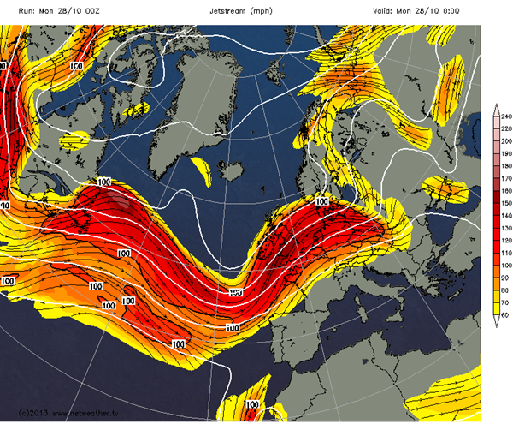European Windstorm Christian (St. Jude)
Status: Closed
| Type of posting | Posting date(EST): | Summary | Downloads |
|---|---|---|---|
| Update 2 | 11/7/2013 1:30:00 AM |
|
|
| Update 1 | 10/30/2013 6:55:00 AM |
|
|
| First Posting | 10/28/2013 11:26:00 AM |
|
First Posting | Summary
Posting Date: October 28, 2013, 11:26:00 AM
Current Situation
Winter storm “Christian” (known as “St. Jude” in the United Kingdom) battered the western shores of southern Great Britain early on Monday, October 28, 2013, as one of the strongest extratropical cyclones to affect the region in perhaps a decade. When it reached Britain’s southern shores, the storm was packing winds of 130 km/h (80 mph) and caused waves exceeding 7.5 meters (25 feet). Five people have been killed, while about 600,000 homes in Britain and 75,000 in France lost power. Rail, sea, and air transportation have been significantly disrupted with rail lines obstructed by over 100 fallen trees. Christian is expected to increase in strength and will impact northern Germany and Denmark with even stronger winds as it travels towards Scandinavia.
Meteorological Conditions
Unlike most winter storms, which reach their peak intensity over the Atlantic Ocean, Christian increased its intensity while crossing Great Britain. This was due to the shape of the jet stream, which brought warm air close to the United Kingdom and packed the strongest winds in back of the storm and along its southern flank. A meteorologist at the BBC has indicated that the storm may have included a sting jet: a region of high-speed, damaging winds on the southern flank of a storm, which is caused by rapidly descending cool dry air that comes into contact with warmer moist air. The existence of a sting jet has yet to be verified however.
At midnight, the storm’s central pressure reading was 981 mb. Wind speeds reached 119-121 km/h (74-75 mph) in areas around Lydeham, near Swindon; Yeovilton, in Somerset; and Hurn, near Bournemouth. A gust of 159 km/h (99 mph) was recorded at Needles, Old Battery on the Isle of Wight at 5:00 GMT. On Île d'Ouessant, Finistère, France, a gust of 133 km/h (83 mph) has been reported.

The jet stream at midnight, October 28, 2013 (Source: Netweather.tv)
Reported Impact
The storm has claimed four lives in Great Britain and a fifth in Amsterdam, Netherlands, mostly due to falling trees. A falling tree caused a gas explosion and serious damage to several houses in London, three of which collapsed. Many of Britain’s transportation systems, including roads, trains, and airports, have been shut down. Britain’s Network Rail has said the damage is “worse than expected” due to more 100 fallen trees obstructing the lines. Limited train service has resumed however.
Commuter rails north of London and across the central region are closed as are rails servicing the Netherlands. In Suffolk, a double-decker bus was blown over, injuring several people. The heavily used Dartford Crossing, which links London with Essex, has been closed due to heavy winds. Heathrow Airport has cancelled about 130 flights and another 50 flights were cancelled at Amsterdam’s Schiphol Airport. Incoming and outgoing vessels have been delayed at Rotterdam Port, Europe’s busiest shipping port.
Other reports indicate collapsed scaffolding, sign damage, and damage to cars and homes due to falling trees. About 600,000 homes are without power in Great Britain while 75,000 homes are without power in France. The Dungeness B nuclear power station was automatically shut off but is back in service with backup generators.
Britain has dubbed the storm “St. Jude” after the patron saint of lost causes, who is traditionally celebrated on October 28. Its official name, as provided by the Freie Universität Berlin on October 26, is “Christian.”
Exposure at Risk
Most of the residential buildings in the United Kingdom are detached, semi-detached, or terraced (row) houses and are primarily of masonry construction. Residential building stock in other areas of Europe that may be affected by Christian is also predominantly of masonry construction. Mid-rise residential buildings generally have exterior non-load bearing walls made of masonry although they may have light-gauge steel stud walls or concrete panels. When built areas are subjected to high winds, most of the damage is limited to the rooftops and chimneys of residences, although walls are often damaged by flying debris.
For commercial exposures, the construction type is approximately 50% masonry with the remaining construction split between steel frame and reinforced concrete. Little structural damage to these construction types is expected for wind speeds of the order widely experienced from Christian although damage to cladding, signage, and some isolated roof covering damage could occur.
Forecast
By 13:00 GMT, October 28, 2013, the storm had dissipated over Great Britain, but heavy winds and rain are still affecting the region. Christian is impacting Germany with record wind speeds and will travel onward into Denmark and Scandinavia. AIR is monitoring this storm closely and will provide updates as warranted.